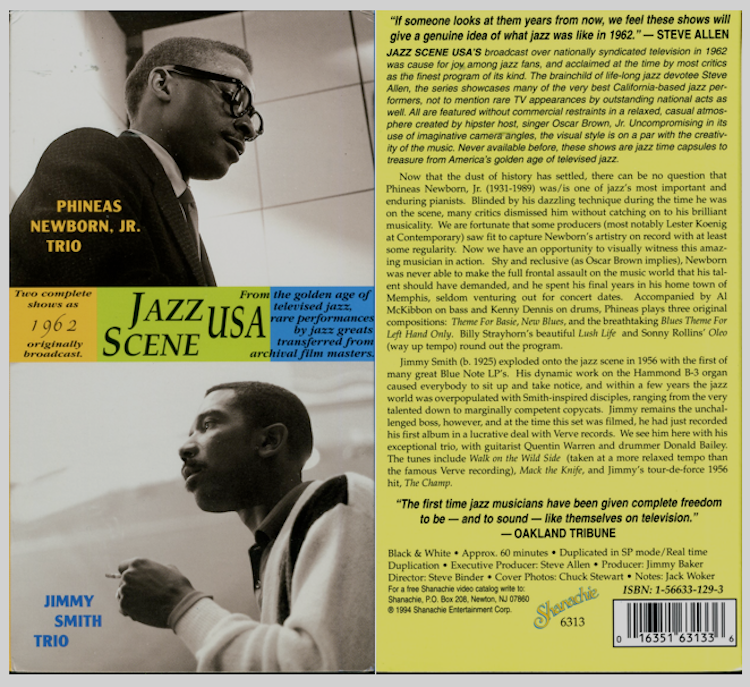JAZZ SCENE U.S.A. #25
BEN POLLACK & HIS PICK-A-RIB BOYS
I am in the process of moving my work on this platform to a new home that unites all of my jazz research under one roof. Thank you for looking at my work here at google blogger. I think you will find the new home more user friendly with links and tags to all of my research. This link will take you to this research at the new site where I have updated the links to Jazz Scene USA segments on YouTube.
MONDAY, NOVEMBER 26, 1962
CBS TELEVISION CITY, LOS ANGELES, CA
Commentary © James A. Harrod, Copyright Protected; All Rights Reserved
When Steve Allen and Jimmie Baker tapped Ben Pollack to appear on the Jazz Scene U.S.A. syndication series Pollack provided a link and historical perspective to the jazz series when the host, Oscar Brown, Jr., asked Pollack to identify the notable jazz stars that had their start in bands that Ben had organized during his career. The brief biography reprinted below from allmusic.com notes these figures that are not listed in the script as Pollack was replying ad lib to screen projections during the filming of the segment. The photo by Cecil Charles [below] was taken at the Beverly Cavern, a long standing bastion for traditional jazz in Los Angeles.

Ben Pollack was a talented drummer and an even better bandleader, with a great ear for talent but none of the luck needed to hold onto his discoveries. He always worked without ever quite hitting the big time himself; but his bands of the 1920s, 1930s, and 1940s included such future luminaries as Glenn Miller, Benny Goodman, Jimmy McPartland, Harry James, Yank Lawson, Muggsy Spanier, Jack Teagarden, Joe Marsala, Eddie Miller, Frank Teschemacher, Dick Cathcart, Irving Fazola, Freddie Slack, and Bud Freeman.
Pollack was born in Chicago, to a family in the fur business. He loved music, however, and took up the drums in school. He played drums in various high-school groups and an all-city band, and also picked up occasional work with professional outfits while still in his teens. Pollack became a member of the Harry Bastin Band, before moving on to work with a groundbreaking ensemble as the drummer for the New Orleans Rhythm Kings, the pioneering white Dixieland ensemble, during the early '20s. Pollack was supposed to go into the family business, but decided to stay in music, and for a time he took over the Bastin band in Los Angeles.
He formed his own band in 1926, and for the next eight years he was host to some of the biggest future talents in jazz, as Benny Goodman, Glenn Miller, Jack Teagarden, Jimmy McPartland, and later, Yank Lawson and Matty Matlock passed through his lineup. The group finally broke up in December of 1934, and its membership immediately became the core of Bob Crosby's band, which went on to years of success in that capacity. Pollack turned right around, however, and put together a new band that included Harry James and Freddie Slack in its lineup.
Pollack soldiered on, never venturing far from the Dixieland style that he favored, leading bands in New Orleans, Chicago, and Los Angeles, where Muggsy Spanier became an alumnus. In 1942, he became the leader of the touring band working behind music/comedy star Chico Marx. By this time, the field of big-band music was dominated by his former alumni, most notably Miller, Goodman, and James. Pollack was working out of New Orleans in the late '40s, and hosted the Second Annual Dixieland Jubilee in 1949, after which he led a sextet. Pollack was an important and popular enough figure among his fellow musicians to justify appearing (as himself) in the 1955 feature film The Benny Goodman Story (starring Steve Allen as the legendary clarinetist and bandleader), but by the late '50s he had left music in favor of opening a club of his own in Los Angeles and then a successful restaurant in Palm Springs, California. Pollack recorded throughout his career, for Bluebird, Brunswick, and Vocalion, among other labels.
© Bruce Eder, allmusic.com
Ben Pollack, leader, drums; Gene Bolen, clarinet; Bill Campbell, piano; Dick Cary, trumpet; Warren Smith, trombone and Walt Yoder, bass.
Production credits:
Host: Oscar Brown, Jr.
Executive Producer: Steve Allen
Producer: Jimmie Baker
Director: Steve Binder
Associate Producer: Penny Stewart
Associate Director: George Turpin
Technical Director: Dick Hall
Lighting Director: Leard Davis
Audio: Larry Eaton
Art Director: Robert Tyler Lee
Jazz Consultant: John Tynan
Title Films: Grant Velie
Cameras: Bob Dunn, Ed Chaney, Gorman Erickson, Pat Kenny
The Howard Lucraft photo that greatly enhances this presentation has been provided courtesy of CTSIMAGES. The author would like to extend a most heartfelt thanks to Cynthia Sesso, Licensing Administrator of the Howard Lucraft Collection. Please note that these photos remain the property of the Howard Lucraft Collection and are used here with permission. Any inquiries regarding their use, commercial or otherwise, should be directed to: Cynthia Sesso at CTSIMAGES.

























































